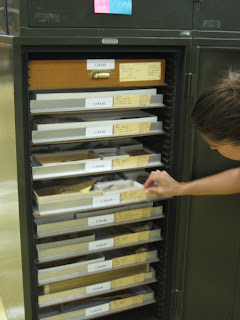

Our first step was to take the old label off of a door, open the cabinet, make a quick inventory of what was labeled on each drawer and made note of it to add to the new label. In most cases, cabinets contain 10 drawers holding a variety of fossils from intact skulls to fragmented ribs, from phalanges to pelvises and all from different localities.
Often the old labels reflected only partial information. The original labels had been created over many decades by different teams of people emphasizing elements dependent on their background be it scientist, intern, or volunteer. This yielded inconsistencies in the information presented as well as the style.
It was important to have labels that were not only consistent but also that would hold up to the test of time. Thanks to the grant provided by National Science Foundation,we were able to print the new labels on archival quality cardstock, one of the many improvements to the collection. The new labels are now consistent in reflecting the family, genus, species for each cabinet. Where applicable, general geographic locality or description was listed. The new labels we created using Adobe PageMaker which allowed us to create a master template to ensure a consistent layout for information.



This enables researchers and scientists to more effectively and efficiently locate specimens. Without such a system, specimens are not as easily accessible, if at all. If you can't find it, it's as if it isn't there at all!


Thanks to our select group of volunteers, the project has been inching toward completion. The task of labeling all 696 cabinets will facilitate future projects of inventory, rehousing, cataloging. In addition to completely labeling floor three, the volunteers have also worked on lining drawers, flagging damaged, uncatalogued, unorganized specimens, and inventory. Carefully documenting each step of the processes is imperative in maintaining consistency throughout all stages of the project.






